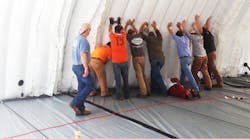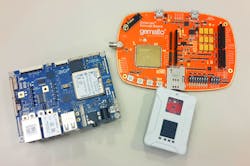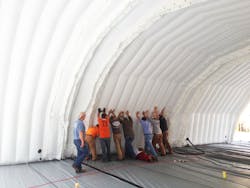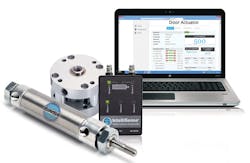Download the PDF of this article.
Imagine a factory where a quick glance at our phones or tablets will tell us everything we need to know about inventory, maintenance, output, and more. A swipe of a finger on a touchscreen could adjust production lines to market fluctuations. Such capabilities are not a vision of some far-off future; they’re here today and more affordable than you think. To make sure you are investing properly in your manufacturing future, this article covers three affordable ways to implement the Industrial Internet of Things: developer boards, wireless sensors, and plug-and-play systems and why and how companies are already using them.
While large manufacturers, such as Ford and Boeing, are able to invest heavily in new technologies, other companies are finding ways to collect data that will make both the engineers and accountants happy. “The key is to come up with an IIoT solution so cost-effective that it is a no brainer. It’s cheap, it’s easy to integrate, and it gives us data – no arguments,” claims Jeremy King, product marketing manager for sensing technologies at Bimba. Here are some of the more cost-effective approaches to implementing IIoT:
While there are many types of IIoT boards, overall an IIoT developer board will offer multiple ways to connect and withstand higher temperatures and vibrations. The more Maker type boards like Arduino and Raspberry Pi may not be robust enough for the shop floor. Pictured here are Gemalto’s Cinterion, Bosch Rexroth’s XDK, and DIGI’s i.MX6UL developer boards.
Industrial developer boards (often under $200). Arduino’s are cost-effective while helping people learn more about electronics and IoT. In fact, many companies have produced industrial strength developer boards for IoT. To accelerate learning and problem solving, many companies also offer developer-board workshops, dashboards, and online resources. Access to dashboards is sometimes a cost-effective monthly subscription. Some workshops are free, or a few hundred dollars to encourage the use of the developer-board company’s technology.
Despite the low cost, many engineers may be too busy with their daily tasks to start an embedded programming course. As a result, developer boards are great for those with programming experience and for offering continued education or training. Industrial developer boards let engineers take things into their own hands. Here are four sensors or initial projects to experiment with:
- Vibration: An increase in vibration can show that there is degradation in a machine. This could offer data for predictive maintenance. For example, if a vibration starts to exceed a set point, it could mean the ball bearings need to be replaced soon or that the machine’s lubrication should be checked. This data might not tell you what is wrong, but it can indicate that you may want on keep an eye on a machine.
- Temperature: Chemical and food processing companies could lose a lot of money if temperature changes a few degrees in storage or processing. In other industries, increasing temperatures can indicate that an electrical cabinet needs more cooling or an electronic device or motor is not operating effectively. This information might lead to longer life cycles while minimizing maintenance.
- Pressure: Simple plug-and-play systems, which are popular for hydraulic and pneumatic processes, have been developed to notify workers about leaks and other problems. This could decrease the energy consumed by compressors and extend the compressor’s life. In addition, this data could indicate when pneumatic equipment is not operating at speed, which could save products from being scrapped.
- Humidity: Some materials and chemicals are sensitive to heat and humidity. In fact, chemical processes might not meet quality standards if they are manufactured in an area with high humidity. This information could be handy if you use adhesives or paints in an environment that isn’t HVAC controlled.
Data, Not Hype
An engineer needs time to learn how to use the developer board well enough to handle their individual problems. Identify the problem and what should be changed. “When I used an IoT solution to help Kraft food production, I never used the term IoT,” says Sam Cece, CEO of Swift Sensors Inc. “They don’t need the engineering specks or buzzwords. They just need, for example, a notification when the temperature of the vinegar fluctuates more than they want it to.”
This is an easy to use temperature and humidity sensor. It is powered by a replaceable 3V coin cell battery and communicates via BLE to a Wireless Bridge. The sensor can store data for up to 72 hours if it loses communication with the Bridge.
Industrial wireless sensors (starting at about $100/sensor). Thermal regulation, remote or local, is helping the food industry. Having employees walking around checking gauges can consume time and money. You also only get one data point each time the employee walks past the gauge or human machine interface (HMI). In the case of Kraft, the facility already had sensors on the compressor and condensers. A third-party technician would stop in once a month to check everything, and once a quarter, Kraft would receive a report. “If vinegar is kept above 42 degrees for more than an hour, the pH level is changed and the material is scrap, and Kraft was receiving old data,” explains Cece. Wireless sensors range in price, but you can find some online for around $100 per sensor.
The previous example indicates the importance of more data and the speed at which it is delivered. For vinegar, you might want data every minute. But there is no reason to use bandwidth to send data every millisecond if it isn’t necessary. According to Powerlink, technology, control, and automation data for buildings can be sent every 100 to 10,000 milliseconds.
So many data points may seem like overkill, but it may be needed to provide crucial verification and validation. For example, a large aerospace manufacturer imported parts to the United States from Italy. Unfortunately, an invasive type of snail was found in the shipping containers that left the company with two options: send the containers back or lower the temperature of the containers for a few days to kill any snails and larvae inside. Because the parts were needed immediately, an insulated tent encased the containers to try for the latter option. The “industrial bouncy castle,” as described by the CEO of Qwik Cold Curt Mather, was outfitted with KE2 Thermsolutions to document and regulate the temperature inside the insulated tent. This made the governing body happy, and enabled the parts to be shipped to the customer within a reasonable amount of time.
An insulated tent and proper thermal controls with documentation helped a manufacturer receive parts over a winter break rather than having to reorder the shipment from Italy when customs found evasive snails in the containers.
What Is Data Trying to Tell You?
Beyond documentation, many companies are wrestling with how to manage all of the data being collected by an IIoT system. “Many production lines are already collecting data, but the data isn’t being used,” says Dan Yarmoluk, IoT business development at ATEK Access Technologies. “Companies use less than 1% of the data they collect.” Many machines have an HMI, but the data on it is isolated, essentially making it like a data island. If data isn’t connected, and production goals have created tunnel vision, engineers might not have a big enough picture to see where improvements can be made.
Eliminating such data islands can be an important and sometimes an easy step toward an effective IIoT plan. After all, aggregating data might help provide a root cause analysis or a bigger picture to fix reoccurring issues permanently.
The Siemens Sinamics V20 helps access to isolated information. It is a WiFi hotspot that allows push notification to alert users if data exceeds set parameters, and could be programmed to provide control.
The first step is to know what machines are already collecting data. Then, one must determine if isolated data can be connected via a cable, like Ethernet, or setting up a wireless transmitter. Next, it is important to identify what equipment doesn’t have data but would add value if it did. Data from multiple sensors can help to verify and/or refine information so that a better, more educated decision can be made. Wireless sensors and some plug-and-play options are available for quicker setup in terms of connectivity. The biggest value of these pre-engineered solutions is not that they collect data, but that they communicate what data means to the user.
Companies like Pillar and Swift Sensors offer easy-to-use wireless sensors. Swift Sensors deployed hundreds of sensors around Kraft Foods Inc. to save time and money, while Pillar does a similar thing with a focus on construction. “We can offer protection in a couple different ways,” says Alex Schwarzkopf, CEO of Pillar Technologies. “Offering real-time data on dashboards is over. No one wants to know what the temperature and humidity is every second of the day. However, when the combined data indicates a potential mold problem or fire, users do want to be alerted.”
This information can also protect workers by sending alerts about particulates that may cause breathing problems or environmental conditions that may cause health concerns from exposure (for example, heat exhaustion, hypothermia, etc.). Simple, easy-to-install sensors can be an affordable way to start collecting data and figuring out where IIoT devices may help production.
In some cases, data and notifications are all production needs. For example, if a motor fails, vibration and temperature data can be recorded with a wireless sensor. If the motor operates properly for two weeks or months, that could be the initial set limits. If the vibration or temperature exceeds these limits, a technician can be notified. Then correlations between the data and what was happening at the time a notification was sent can be made. Over time, more accurate set points can be programmed.
N-Vale and Sample Size
Some plug-and-play IIoT solutions have already done the research to translate data to help with troubleshooting. One example is a pneumatic arm that was responsible for placing a seal in a bottle cap. Over time, the pneumatics would wear, leak, and become out of sync with the conveyor. This would produce a faulty cap. It takes about an hour for the faulty cap to reach a worker able to correct the problem or stop production. During that hour, thousands of now scrap parts are produced.
Bimba made a system that retrofits into a pneumatic system and alerts a technician of leaks or other issues. This particular model uses a pair of pressure sensors that calculates data to figure out if, for this example, when the pneumatic arm stops extending fast enough to place the seal properly.
“It is possible to develop a system, like the IntelliSense, to do more,” says King. “Going forward, we could tie the data over a Modbus to the controller. This could adjust the conveyor speed to match the changing performance of the pneumatic cylinder.” While decreasing production, it has the option to decide when to shut down for maintenance.
Plug & Play Systems (will change based on product and distributor, but $300 to about $600). “Our first question is: Why would a manufacturer spend a few hundred dollars on a $30 part that takes 15 minutes to swap?” says King. “The answer is, because the cost of the lost production and downtime could be much greater.” Cost-effective, easy to integrate systems for pneumatics may be a popular IIoT solution. 70% of manufacturers use pneumatics, according to Nexmatix - an IIoT pneumatic valve solution. “A lot of manufacturers already use control valves,” explains Vicki Gonzalez, CEO of Nexmatix. “We just put a microprocessor, sensor and analytics on it to make it smart and energy efficient. Last year, both an engine and tire manufacturer were able to reduce 25 to 28 percent of the amount of compressed air used.” Plus, being able to pinpoint leaks or identify machines that stay on when they don’t have to is low hanging fruit, but it does provide an initial ROI. When the valve includes a sensor and the analytics, the low hanging fruit is enough to justify the investment. And process data might show if an additional investment might yield more benefits.
With wireless sensors able to be setup for under $100, even large companies that might have the money to invest in IIoT are using these simple solutions. The Kraft Food example used earlier simply zip tied cost-efficient, wireless sensors on key elements of the production line. “We’ve saved hundreds of man hours in productivity over the past year and improved our operations,” notes William Thacker, complex electrical engineer supervisor at Kraft-Heinz Foods.
With so many easy to use solutions, why aren’t we seeing more IIoT in manufacturing? First, you don’t know you have a problem if you are only focused on production. Engineers need time to review the production line to find the greatest sources of unnecessary labor, maintenance, and downtime. Second, you don’t know how big the problem is without data. And chances are, even if you have some data, you don’t have enough to figure out what to do about the problem.
This is where data analytics and basic statistics come into play. Here are some rules of thumb:
- If you only have data from your line, the sample size is probably not big enough for accurate statistics, so you’re still presenting educated guesses.
- If you have data outside the tolerances you have set, is that a special or common occurrence? Honing a machine to special or rare occurrences may create more adjusting and less solutions. This is where analytics and statistics will guide the process. Take a refresher in N-Value or sample sizes.
- As data operates outside of the set tolerances, you still have to let it fail in order to prove that the data was correct. Talking to others in industry will help you expand your sample size and make better predictions.
Remember that having the data from your line or plant may not provide a proper sample size. Collaboration can provide better sample sizes. “Engineers need to be communicating to each other all the time, inside and outside of their industry,” says Jeremy Wright, director of product management at Advanced Technology Services (ATS). “I can see information from multiple industries, and it is like the same TV show with different actors. You might see an engineer at a wood pulp plant and another at a gummy bear factory, and they might be using the same gearbox that is giving both engineers the same problem. This is when collaboration or a third party that collects data, starts noticing patterns.” While IIoT can offer this data, it seems communication among engineers is just as valuable.
No matter how advanced our lines become, tinkering to build skills, knowing what solutions are on the market, and collaboration will never go out of style. IIoT solutions just help engineers focus on what they do best.






